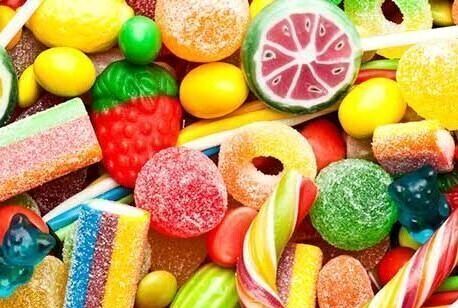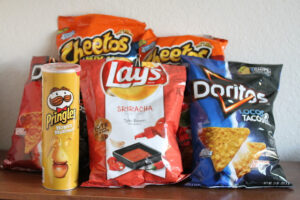Candy, also called sweets (British English) or lollies (Australian English, New Zealand English),[a] is a confection that features sugar as a principal ingredient. The category, called sugar confectionery, encompasses any sweet confection, including chocolate, chewing gum, and sugar candy. Vegetables, fruit, or nuts which have been glazed and coated with sugar are said to be candied.
Physically, candy is characterized by the use of a significant amount of sugar or sugar substitutes. Unlike a cake or loaf of bread that would be shared among many people, candies are usually made in smaller pieces. However, the definition of candy also depends upon how people treat the food. Unlike sweet pastries served for a dessert course at the end of a meal, candies are normally eaten casually, often with the fingers, as a snack between meals. Each culture has its own ideas of what constitutes candy rather than dessert. The same food may be a candy in one culture and a dessert in another.[2]
History
A Japanese vendor selling sweets in “The Great Buddha Sweet Shop” from the Miyako meisho zue (1787)
The word candy entered the English language from the Old French çucre candi (“sugar candy”). The French term probably has earlier roots in the Arabic qandi, Persian qand and Sanskrit khanda, all words for sugar.[3]
Sugarcane is indigenous to tropical South and Southeast Asia. Pieces of sugar were produced by boiling sugarcane juice in ancient India and consumed as khanda.[4][5][6][7][8] Between the 6th and 4th centuries BCE, the Persians, followed by the Greeks, discovered the people in India and their “reeds that produce honey without bees“. They adopted and then spread sugar and sugarcane agriculture.[9]
Before sugar was readily available, candy was based on honey.[10] Honey was used in Ancient China, the Middle East, Egypt, Greece and the Roman Empire to coat fruits and flowers to preserve them or to create forms of candy.[11] Candy is still served in this form today, though now it is more typically seen as a type of garnish.
Before the Industrial Revolution, candy was often considered a form of medicine, either used to calm the digestive system or cool a sore throat. In the Middle Ages candy appeared on the tables of only the most wealthy at first. At that time, it began as a combination of spices and sugar used as an aid to digestion. Banquet hosts typically served these types of ‘candies’ at banquets for their guests. One of these candies, sometimes called chamber spice, was made with cloves, ginger, aniseed, juniper berries, almonds and pine kernels dipped in melted sugar.[11]
The Middle English word candy began to be used in the late 13th century.[12][13]
The first candy came to America during the early 18th century from Britain and France. Only a few of the early colonists were proficient in sugar work and sugary treats were generally only enjoyed by the very wealthy. Even the simplest form of candy – rock candy, made from crystallized sugar – was considered a luxury.[14]
Industrial Revolution
The candy business underwent a drastic change in the 1830s when technological advances and the availability of sugar opened up the market. The new market was not only for the enjoyment of the rich but also for the pleasure of the working class. There was also an increasing market for children. While some fine confectioners remained, the candy store became a staple of the child of the American working class. Penny candies epitomized this transformation of candy. Penny candy became the first material good that children spent their own money on. For this reason, candy store-owners relied almost entirely on the business of children to keep them running. Even penny candies were directly descended from medicated lozenges that held bitter medicine in a hard sugar coating.[15]
In 1847, the invention of the candy press (also known under the surprising name of a toy machine) made it possible to produce multiple shapes and sizes of candy at once. In 1851, confectioners began to use a revolving steam pan to assist in boiling sugar. This transformation meant that the candy maker was no longer required to continuously stir the boiling sugar. The heat from the surface of the pan was also much more evenly distributed and made it less likely the sugar would burn. These innovations made it possible for only one or two people to successfully run a candy business.[14]Our Mutual Friend, January 7, 1885, satirical cartoon by Joseph Keppler, warning of the dangers of color additives used in candy.
As the path from producer to market became increasingly complicated, many foods were affected by adulteration and the addition of additives which ranged from relatively harmless ingredients, such as cheap cornstarch and corn syrup, to poisonous ones. Some manufacturers produced bright colors in candy by the addition of hazardous substances for which there was no legal regulation: green (chromium oxide and copper acetate), red (lead oxide and mercury sulfide), yellow (lead chromate) and white (chalk, arsenic trioxide).[16]
In an 1885 cover cartoon for Puck, Joseph Keppler satirized the dangers of additives in candy by depicting the “mutual friendship” between striped candy, doctors, and gravediggers. By 1906, research into the dangers of additives, exposés of the food industry, and public pressure led to the passage of the Pure Food and Drug Act, the first federal United States law to regulate food and drugs, including candy.[16]Karl Fazer (1866–1932) founded the successful Fazer company in the 1890s, which at the time specialized exclusively in the candy and confectionery industry.[17]
Classification
Sugar candies include hard candies, soft candies, caramels, marshmallows, taffy, and other candies whose principal ingredient is sugar. Commercially, sugar candies are often divided into groups according to the amount of sugar they contain and their chemical structure.[18]
Hard-boiled candies made by the vacuum cooking process include stick candy, lemon drops and horehound drops. Open-fire candy, like molasses taffy and cream taffy, is cooked in open kettles and then pulled. Pan work candies include nuts and other candies like jelly beans and sugar-coated almonds, made by coating with sugar in revolving copper kettles. Gum work candy is cooked in large kettles fashioned for melting and molded, dried and sugared like gum drops. They are soaked for a time in sugar syrup to allow crystals to form



